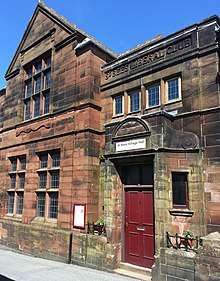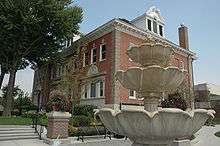Village hall
A village hall is a public building in a village used for various things such as:
United Kingdom

In the United Kingdom, a village hall is usually a building which contains at least one large room (plus kitchen and toilets), is owned by a local government council or independent trustees, and is run for the benefit of the local community. It is estimated that there are over 10,000 such village halls.[1]
Such a hall is typically used for a variety of public and private functions, such as:
- Parish council meetings
- Polling station for local and national elections
- Sports club functions
- Local drama productions
- Dances
- Jumble sales
- Private parties such as birthdays or wedding receptions
Village halls are generally run by committees, and if not already part of a local government body such as a parish council, then such committees are eligible for charitable status.[2] They may have other names such as a Village Institute or Memorial Hall. In some localities a church hall or community centre provides similar functions.
United States

In the United States, a village hall is the seat of government for villages. It functions much as a town hall or city hall.
See also
External links
References
- ACT website Jan 2019
- Use of Church Halls for Village Hall and Other Charitable Purposes, Charity Commission, United Kingdom, July 2001.
- "Neuadd Dyfi". Retrieved 2 November 2009.